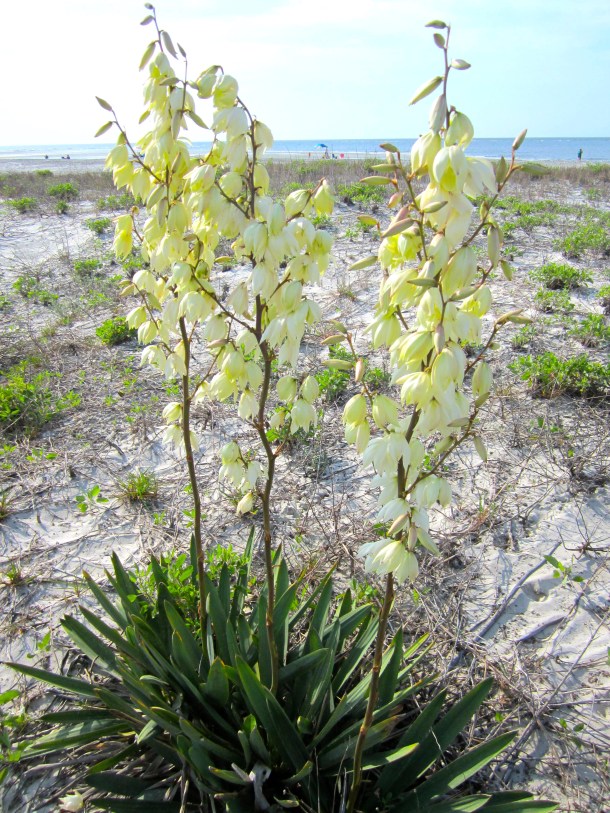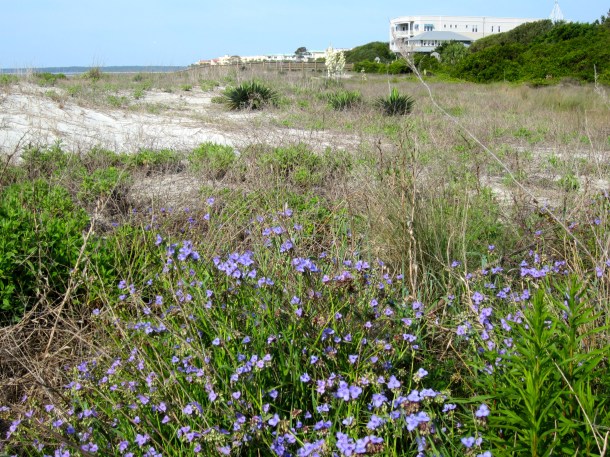For most people, a trip to the beach is all about relaxation. But the gear-laden trek from the parking lot to the beach blanket can be anything but relaxing.
In fact, most visitors are so busy juggling kids, beach chairs, and coolers that they hardly notice the tiny, micro-desert they walk through on the way.
Yucca plants are native to hot, dry parts of North and South America, and are most widely distributed in the desert Southwest of the US. But I spotted this beautiful, blooming yucca just off the path to the beach on St. Simons Island, Georgia.
Nature ensures that vegetation creeps into every nook and cranny, but somehow, this yucca seemed out of place. Luckily, Taylor Schoettle’ s excellent A Naturalist’s Guide to St. Simons Island, which is my go-to source for all things outdoorsy on the island, helped me find the answer.
This guide explained that in the short distance from the parking lot to the beach, a number of specific plant ecosystems exist. Surprisingly, one of these zones is a “desert,” and this narrow band is where this yucca was growing.
Above the high tide line, the first sand ridge, called the primary dune, is the desert of the beach. Constant wind and salt spray, unrelenting heat and sunshine, shifting sand, and quick water drainage make living conditions harsh for both plants and animals. And like all deserts, the biggest struggle is for water.
Plants that survive on this dune have developed two different types of root systems to provide water. One is a near-surface, web-like system designed to quickly capture rainwater before it drains through the sand. Or like the yucca, a deep taproot struggles down to the water table. Either system works, but as the sparse vegetation indicates, life in this micro-desert is tough.
So on your next trip to the beach, unburden yourself at the primary dune, and have a look around the desert.
Happy Trails,
James
Last Updated September 7, 2023
P.S. For those interested in the natural aspects of beaches, marshes, and barrier islands, A Naturalist’s Guide to St. Simons Island is an excellent resource. It’s comprehensive, easy to understand, and even though it’s specific to St. Simons, it provides lots of general information for any location.



beautiful……and educational !
Thanks Anantha. Until I saw this yucca, I hadn’t really thought about it. ~James
do enjoy your ‘insightful’ writings and look forward to more
when get a chance, do have a go at mine as well though the content tend to be more toward the performing art scene here in India. I try and bring out the lesser known (as you do) and dying side of it
Yucca on the beach! That’s awesome. Come to think of it. I’ve probably seen that here in San Diego, but never gave it much thought, because I always get caught up in how cool the Dr. Seuss-like desert plants are. (A lot of people have desert gardens as well, so I’m used to seeing them once in a while.) Gonna keep my eyes peeled from now on! 🙂
Thanks Rik, for dropping by the blog, and for the comment. Until I saw this yucca on the beach, I’d never given it much thought. San Diego is semi-arid, so I can believe yuccas there. But St. Simons is anything but arid, so a “desert” at the beach was a real surprise for me. BTW, I checked out your off the grid site and DIY campers and am looking forward to digging deeper. ~James
It’s beautiful Yucca Plant with white bloom…………
Thanks Mona. These yuccas in bloom really are gorgeous. And they are pollinated by only one type of wasp when they bloom. ~James
The beach that we like — an area called Agia Marina, near Chania, Greece — also features an enticing area between parking lot and beach. Unlike the one you describe, however, our inter-beach area is all nightclubs. The beach is populated by families and swimmers during the day, but at night, it’s people in their 20s and 30s, partying. The nightclubs cater to that crowd. Not a flower in sight.
Tom, the day/night character difference in beaches in Europe and the Med is well … night and day. We learned this the hard way on one of our early trips. We picked out a small, charming hotel with a balcony overlooking the ocean in Nice. It was quiet and delightful, until about 9pm. It was a weekend night, and when the noise cranked up, it sounded like a drunken soccer match. We pay more attention to these things now. ~James
There is a foggy beach south of San Francisco that has massive agaves growing in one area on it. It is a tough environment. What a beautiful plant!
Somehow, I always thought that with all the water and sunshine at the beach, if you’re a plant, how bad could it be? But you’re right Pam. It’s very tough. And if I learned nothing else from my research for this post, it’s how incredibly fragile the beach is. It’s one of those things you hear all the time, and never really connect with unless you dig deeper. ~James
the flower is very popular in costa rica when it blooms around easter time; it has culinary uses, typically poached then added to sauteed onions and peppers then scrambled with eggs for breakfast.
Wow, great info Lisa. For its size, the a yucca produces lots of blooms, and it’s good to know that they can be used instead of just dropping to the ground. I’m not much of a plain-egg person, but these sound wonderful. Have you had them? ~James
the flowers have a unique flavor – slightly bitter… i haven’t had the opportunity to prepare them myself, and i think there are many other options that they haven’t tried!
let us know if you do some culinary experimentation!
You make yucca plants look divine! And you’re right, we pass right by some of the prettiest things to get to the beach. We have lovely sea oats and sand hills that I barely notice! http://ohtheplaceswesee.com
Thanks Rusha. It seems to be their season on the island, and I’ve seen a few (away from the beach) that were in full bloom and magnificent. And we’ve had lots of summer rain, so the sea oats are flourishing. They play a big role in stabilizing the dunes and are protected in Georgia. ~James
Sea oats and loggerhead turtles are quite protected at Pawleys Island. I got to see a turtle nest moved to safer ground while there this time. Post in the works!
Very cool Rusha! I’ve never seen a real-life egg, so I’m looking forward to your post. ~James
That Yucca is stunning. And I wonder how many people walk past it without even noticing it’s beauty. Thanks for sharing about your small patch of desert! Now you’ve got me wondering if I could grow Yucca’s here in Jordan.
Andrea, I’ve been to Jordan, and I can say that you absolutely can grow yuccas. But, in my time there, I don’t remember seeing any. Do a bit of research first. Even though they’re a hardy desert species, the flowers are pollinated by only one type of wasp. Like most flowering, desert plants, they don’t bloom often, but when they do, they really put on a show. ~James
this reminds me on one of the beaches i went a good 5 years ago, the walk from the main road (because we just went there on commute) to the beach proper was nothing but relaxing as well! it was like a bit of a search for a hidden gem. hehehe
i haven’t seen a yucca plant, but it looks really beautiful and somehow, i feel like it’s lonely (maybe coz it’s droopy?–i have a funny sense of imagination!!). 😀
Kate, if you notice much on the walk to the beach, you’re definitely the exception. As I leave the beach, I see loads of people walking toward the beach, and their eyes are always straight ahead – looking at the lovely ocean and thinking about the book, nap, and the sound of the breaking waves. I like the beach, but I also pay attention on the walk in. ~James
No yuccas on the beaches of Kodiak, James, but lots of beautiful flowers taking advantage of summer before the far north returns to winter. Micro ecosystems have always fascinated me and can be dramatic, like the difference between a south and north facing slope in the mountains, or a creek running through the desert. BTW, I’ve always like yuccas. –Curt
Thanks Curt. Prior to SSI, I didn’t really have much knowledge of micro ecosystems. But barrier islands in the SE US are excellent case studies. They vary from ocean, open beach, dunes, high dunes, scrub, oak hammock, back island marsh, tidal river, marsh (again) and then mainland. It’s pretty amazing really, and I find it incredibly interesting. Who knows, watch this space and there may be a post (or three) about it. ~James
Or four… 🙂
Stunning! I’ve long wanted to go to St. Simon’s Island. We spend our weekends in the summer by a totally different ocean in Rockport, MA. thanks for whisking me away on a Monday afternoon through these pictures and words.
Thanks Marilyn. I can imagine that your beach experience is very different than SSI. Our water temperature is 80 degrees, which is probably higher than your air temp. If you can visit SSI you will definitely enjoy it. Growth has been tightly controlled, and there aren’t tons of lodging options, which keep the crowds down. The island is very bike friendly, and is the very definition of laid back. So if you get a chance, check it out. I’m sure this yucca will still be standing guard by the coast guard station. ~James
I love yucca plants. They are quite showy most of the time, and then spectacular when they bloom. I have always been fascinated with how durable and tough the succulents are. I especially like that you not only took time to notice, but also to share. I probably would have walked by myself without thinking about the plants. The Northwest dunes are pretty much reed grass until you come to the shore pines, seldom more than five feet tall.
Thanks Mike. One thing I’ve noticed since I started blogging is that I’m more observant. I enjoy science and nature, and because these two things are always around me, I always have something to look at and think about. Also, after doing a bit of research for this post, I now realize how incredibly fragile beaches are, and the important part that plants play in maintaining the dunes. As my friend Curt says above, the plant communities really are micro-ecosystems, which I find very interesting. BTW, good luck in the new apartment. ~James
Thanks very much Boyd for the link to our post. ~James